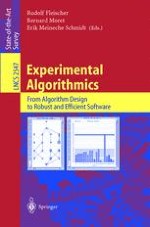Experimental algorithmics, as its name indicates, combines algorithmic work and experimentation: algorithms are not just designed, but also implemented and tested on a variety of instances. Perhaps the most important lesson in this process is that designing an algorithm is but the first step in the process of developing robust and efficient software for applications.
Based on a seminar held at Dagstuhl Castle, Germany in September 2000, this state-of-the-art survey presents a coherent survey of the work done in the area so far. The 11 carefully reviewed chapters provide complete coverage of all current topics in experimental algorithmics.
